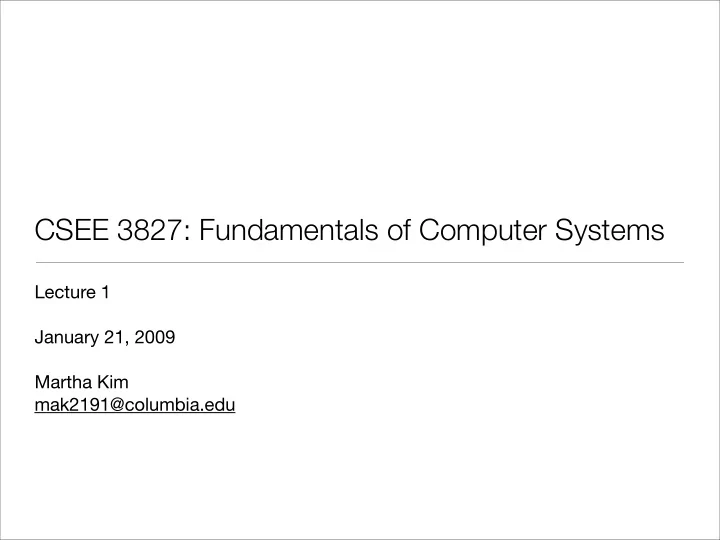

CSEE 3827: Fundamentals of Computer Systems Lecture 1 January 21, 2009 Martha Kim mak2191@columbia.edu
Agenda • Administrative details • Course introduction • Information representation and definitions
Instructor Prof. Martha Kim mak2191@columbia.edu CSB 461 Office hours: Tuesdays and Thursdays, 2-3pm (Email or drop by to schedule other times.)
Teaching assistants Roopa Kakarlapudi Nishant Shah Harsh Parekh
Lectures Mondays and Wednesdays 1:10-2:25pm Fayerweather 310
Textbooks Logic and Computer Design Fundamentals, 4th ed, by M. Morris Mano and Charles Kime Computer Organization and Design, The Hardware/Software Interface, 4th ed, by David A. Patterson and John L. Hennessy
Grading formula Final Exam Eight problem sets • early May (scheduled by University) • handful of practice problems • covers 2nd half of course • one week to complete 20% 40% 40% Midterm Exam • early March (before spring break) • covers 1st half of course
Problem sets Due at start of class on due date. Collaboration policy: In working on the problem sets, feel free to discuss the problems with your classmates. However, no collaboration is allowed in writing up the solutions. Each student is to write up his or her own solution and is expected to be able to explain and reproduce the work she or she submits.
Course webpage http://www1.cs.columbia.edu/~martha/courses/3827/sp09/
Agenda • Administrative details • Course introduction • Information representation and definitions
What does this ... [Source: http://ftp.arl.army.mil/~mike/comphist]
... have in common with this?
growth in performance = growth in raw resources + system design innovation ENIAC Intel Larrabee (1946) (2009) 5,000 400,000,000x 2,000,000,000,000 operations per second faster operations per second 1,167,000,000x 3 49.5 mm 2 8.5’ x 3’ x 80’ (2040 ft ) smaller $500,000 ~$300 1666x cheaper
growth in performance = growth in raw resources + system design innovation Gordon Moore co-founder of Intel Moore’s Law: Density of transistors doubles every two years
growth in performance = growth in raw resources + system design innovation transistors logic gates logic circuits processor memory
Agenda • Administrative details • Course introduction • Information representation and definitions
Number systems: Base 10 (Decimal) • 10 digits = {0,1,2,3,4,5,6,7,8,9} • example: 4537.8 = (4537.8) 10 4 5 3 7 . 8 3 2 1 0 -1 10 x x x x x 10 10 10 10 4000 40 = 4537.8 + + + + 500 7 .8
Number systems: Base 2 (Binary) • 2 digits = {0,1} • example: 1011.1 = (1011.1) 2 1 1 0 1 1 . 3 -1 2 1 0 x 2 x x x x 2 2 2 2 8 2 = (11.5) 10 + .5 + 0 + + 1
Number systems: Base 8 (Octal) • 8 digits = {0,1,2,3,4,5,6,7} • example: (2365.2) 8 2 2 3 6 5 . 3 -1 2 1 0 x 8 x x x x 8 8 8 8 1024 48 + .25 = (1269.25) + 192 + + 5 10
Number systems: Base 16 (Hexadecimal) • 16 digits = {0,1,2,3,4,5,6,7,8,9,A,B,C,D,E,F} • example: (26BA) [alternate notation for hex: 0x26BA] 16 A 2 6 B 0 3 2 1 x x x x 16 16 16 16 1536 = (9914) 10 + 10 8192 + + 176
Hexadecimal (or hex) is often used for addressing
Number ranges • Map infinite numbers onto finite representation for a computer • How many numbers can I represent with ... 5 10 possible values ... 5 digits in decimal? 8 2 possible values ... 8 binary digits? 4 16 possible values ... 4 hexadecimal digits?
Need a bigger range? • Change the encoding. • Floating point (used to represent very large numbers in a compact way) exponent 5.4 x 10 5 • A lot like scientific notation: mantissa 1011 • Except that it is binary: 1001 x 2
What about negative numbers? • Change the encoding. • Sign and magnitude • Ones compliment • Twos compliment
Sign and magnitude • Most significant bit is sign • Rest of bits are magnitude 0110 = (6) 1110 = (-6) 10 10 • Two representations of zero 0000 = (0) 1000 = (-0) 10 10
Ones compliment • Compliment bits in positive value to create negative value • Most significant bit still a sign bit 0110 = (6) 1001 = (-6) 10 10 • Two representations of zero 0000 = (0) 1111 = (-0) 10 10
Twos compliment • Compliment bits in positive value and add 1 to create negative value • Most significant bit still a sign bit 0110 = (6) 1001 + 1 = 1010 = (-6) 10 10 • One representation of zero 1111 = (-1) 10 0000 = (0) 1000 = (-8) 10 10 • One more negative number than positive MAX: 0111 = (7) 10 MIN: 1000 = (-8) 10
How about letters? • Change the encoding.
Some definitions • bit = a binary digit e.g., 1 or 0 • byte = 8 bits e.g., 01100100 • word = a group of bytes a 16-bit word = 2 bytes e.g., 1001110111000101 a 32-bit word = 4 bytes e.g., 100111011100010101110111000101
Next class: binary logic, logic gates
Recommend
More recommend